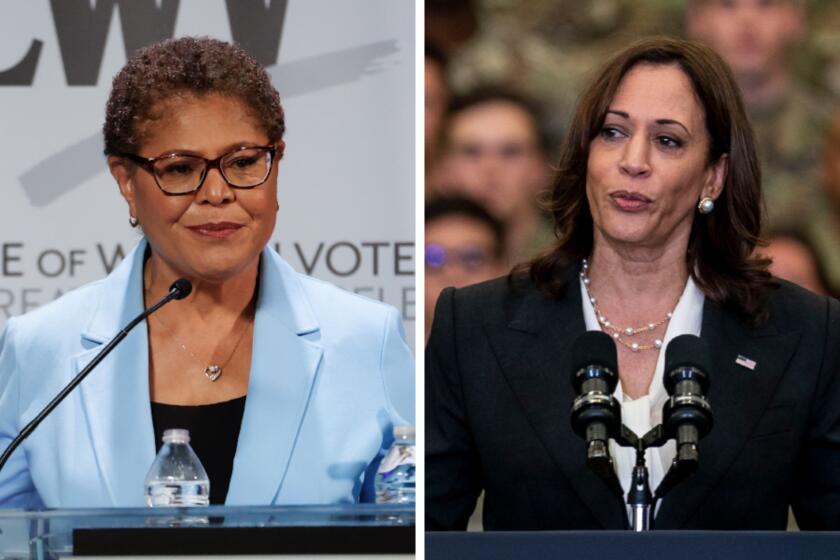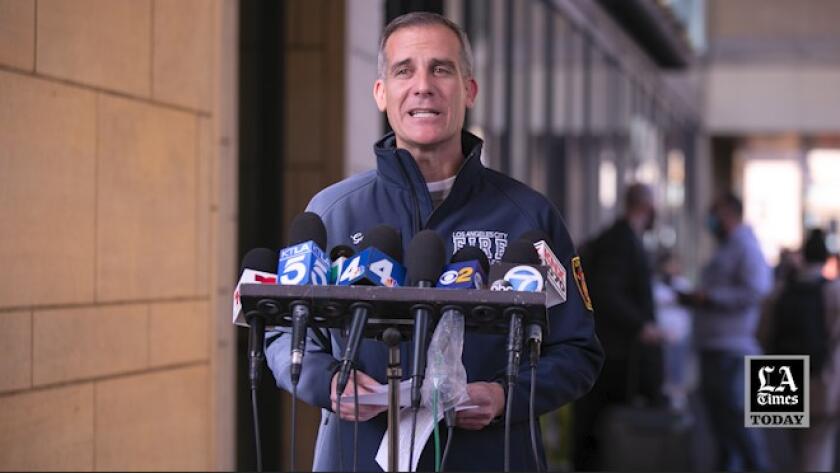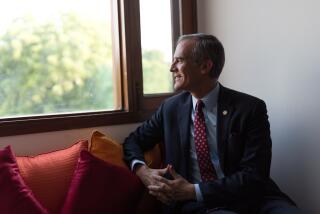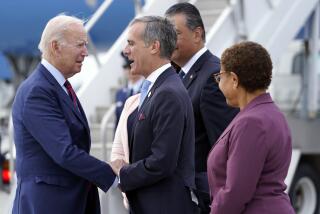Eric Garcetti led L.A. during profoundly turbulent times. How will history judge him?
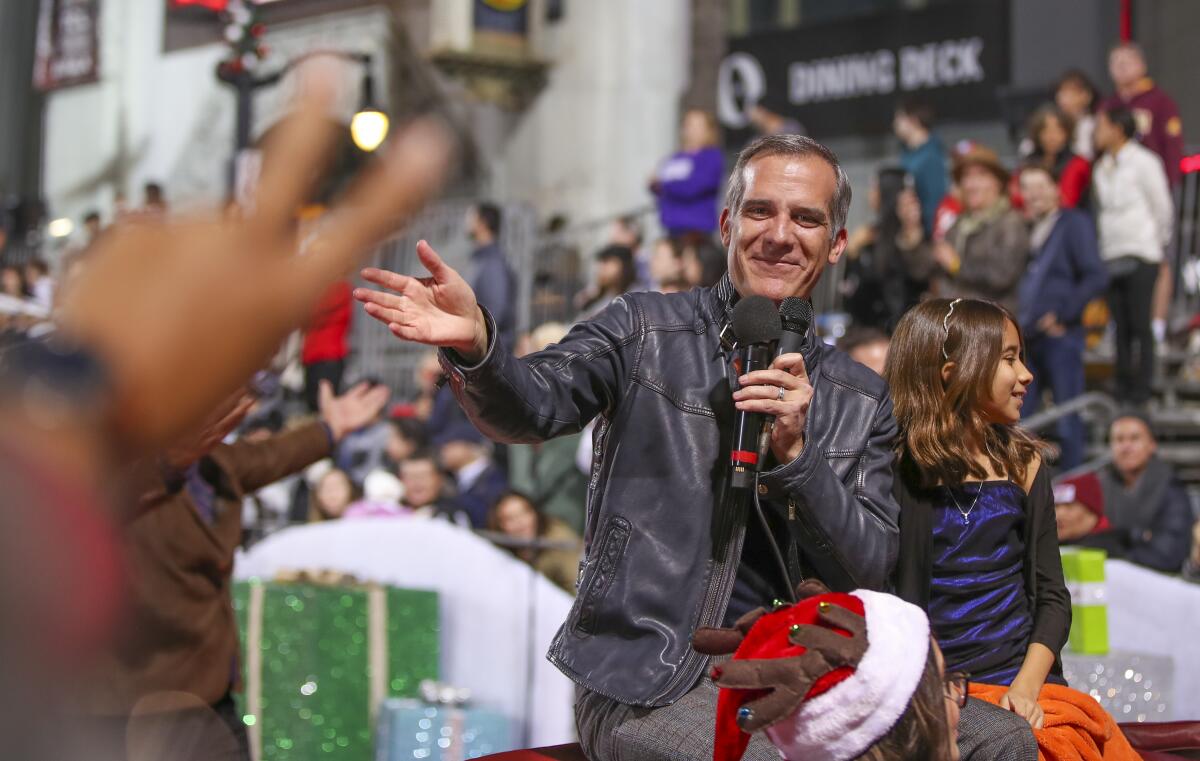
Eric Garcetti glided down the parade route last month, seated atop the backseat of a vintage Chrysler convertible — buoyed by the ebullient Veterans Day crowd that lined the sidewalks of Pacoima.
“Thank you for your service, to both the city and the country,” one man called out. Others shouted, “Go Navy!” at Garcetti, neatly turned out in a dark blue dress uniform from his days in the Navy Reserve. Parents pressed forward to pose their children with one of the parade’s biggest celebrities.
Another bystander punctuated the sunny scene, shouting: “Garcetti in 2024!” Garcetti responded, though much more quietly: “We’ll see.”
Heady scenes like this one once felt as if they would go on and on. The popular and ambitious mayor of Los Angeles presented himself as a plausible candidate for bigger things, perhaps the governor’s office or even the White House.
But that time has passed, at least for now.
Garcetti leaves office Sunday, as L.A.’s longest-serving mayor since Tom Bradley. A year and a half of extra duty — a quirk of an electoral calendar remade to synchronize city and state voting — has felt at times like a siege, clouded by a sexual harassment scandal in his office that cast a shadow on the accomplishments and promise of his first years in office.
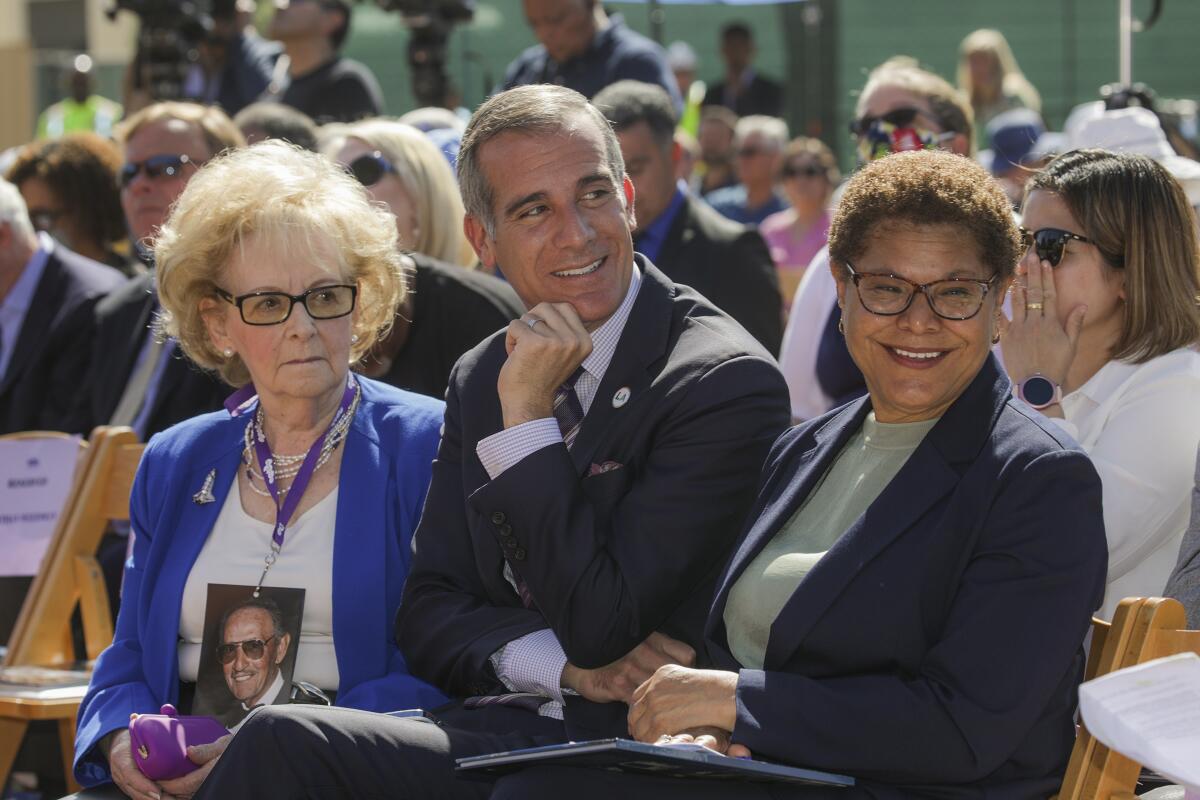
Garcetti exits with his political future murkier than at any time since he came to the third floor of City Hall as a 30-year-old city councilman, more than two decades ago. The U.S. Senate has balked at approving his nomination to a post — U.S. ambassador to India — that is less prominent than he had hoped for and hardly a traditional launching pad to higher office.
He leaves behind a city of stark contrasts.
Vice President Kamala Harris will visit downtown L.A. on Sunday to administer the oath of office to incoming Mayor Karen Bass, the first woman and second Black Angeleno to hold the office.
Even as a robust economic expansion brought gleaming high-rises, new sports stadiums, expanded light-rail service and a tech boom to the L.A. area, housing construction did not keep pace. That helped create an unwanted symbol of the new Los Angeles — the squalid tent village.
Former staffers, political scientists and other observers of city government view Garcetti as someone who wore well enough with many Angelenos, a gifted retail politician who ultimately didn’t transcend the limits of the office and his own cautious nature in order to drive the kind of dramatic changes that might have assured him a loftier perch in the city’s history.
“Fundamentally, he represents what the structure of civic life in Los Angeles has been, which is not particularly dynamic and not capable of capturing very much of the public imagination and giving residents and voters confidence that government is paying attention to things that most concern them,” said D.J. Waldie, a Southern California cultural historian. “That is a reality that every mayor of Los Angeles has confronted in the 20th century and, it appears, into the 21st century.”
Accomplishments, failures: A mixed record
Garcetti helped lift L.A.’s lowest-paid workers with one of the highest minimum wages in America, passed a law to make thousands of buildings more earthquake safe and pushed the extension of rail lines toward the Westside, Los Angeles International Airport and beyond. When COVID-19 descended, he demanded the opening of testing and vaccination sites, while his nightly briefings turned him into the city’s consoler in chief.
And yet those successes can’t blot out a morass at City Hall — one of Garcetti’s deputy mayors ensnared in an alleged pay-to-play scheme, the Department of Water and Power (which the mayor pledged to reform) mired in a bribery and legal scandal that will cost the agency more than $100 million, and a Fire Department shadowed by accusations of hazing and harassment, even as top fire officials skirted punishment.

Yet those deficiencies pale, in the public’s mind, to the city’s failure to get its neediest residents off the streets. Garcetti has acknowledged that he became the public face of homelessness, with the attendant images of sidewalks and underpasses crowded with filthy tents and cardboard hovels.
Late to confront the problem, L.A. has struggled to catch up. The opening of record numbers of shelter and permanent housing beds helped house many, but the lack of a broader base of affordable housing and mental healthcare meant that the ranks of unhoused people did not drop noticeably.
Already coping with that crisis and the exhausting COVID-19 pandemic, Garcetti was also bedeviled in his final years by allegations of sexual harassment against one of his closest aides, Rick Jacobs, raising questions about his credibility and seemingly permissive oversight of top advisors. Jacobs has denied the allegations.
He also faced a drumbeat of criticism from L.A.’s newly energized left, which contended the mayor did not do enough for the city’s most vulnerable citizens. Protests became so intense outside the mayor’s official residence, Getty House, that his wife, Amy Wakeland, filed dozens of complaints with the mayor’s LAPD security detail.
Nonetheless, academics said they expect Garcetti’s tenure to receive relatively solid marks in the long run.
Raphael Sonenshein, director of the Pat Brown Institute for Public Affairs at Cal State Los Angeles, rates the mayor as “better than some of the current conversation has him pegged,” because of his “signal accomplishments” on seismic safety and the COVID-19 pandemic, though Sonenshein noted “a noticeably quiet” end of the Garcetti years.
Peter Dreier, a professor of politics and urban policy at Occidental College, said Garcetti deserves a “B for effort and a B- for execution,” led by good work on the pandemic and environmental initiatives but tarnished by the failure to transcend the city system to build more affordable housing.
Others who have worked more directly with city government view Garcetti as a disappointment, a brilliant student of many things who wouldn’t risk his once-formidable approval rating to get things done, such as a major overhaul of city zoning to spur more housing construction.
Manuel Pastor, USC’s Equity Research Institute director, said the paradox of Garcetti is that he can claim a set of accomplishments, yet his legacy looks “so mixed.” Speaking to KPCC’s Larry Mantle, Pastor said: “I think it’s in part because many times people felt like he was tepid.”
The last broad poll of Garcetti’s standing suggests he has not fallen as badly in the public’s estimation as the leaders of some other big cities. The UC Berkeley Institute of Governmental Studies found that 48% of those likely to vote last spring approved of the outgoing mayor’s performance, while 46% disapproved. (Still, that relative resiliency represented a pronounced falloff from his 62% favorability rating in a 2020 countywide survey by the UCLA Luskin School of Public Affairs.)
The job takes its toll
In his final months in office, Garcetti seldom dropped his public presentation as a leader still enjoying his job.
At the Veterans Day parade, he appeared in full campaign mode — snapping off salutes to others in uniform, taking photos of people sitting curbside and shouting, “God Bless America!” He managed it all while assuring a Times reporter, who rode along, about his conviction that he would soon be leading the American Embassy in New Delhi.
Privately, though, a few associates said the mayor made it clear the job had taken its toll. In his last year in office, Garcetti appeared less engaged to some at City Hall. It also wasn’t clear if he and Wakeland were both still living full time at Getty House. (Garcetti, who has long bristled at questions about his family, insisted to The Times earlier this year that Getty House is “our residence.”)
One person in his orbit found him much more talkative about U.S.-India relations than about the unrelenting homeless crisis. Another said he did not hide his exhaustion at the relentlessness of his job.
The compressed timeline between election day and inauguration is presenting challenges for Mayor-elect Karen Bass.
“He said to me, ‘Being mayor of this town is very, very hard,’” said the second individual, who asked not to be named when sharing what had been a private conversation. “I think he found it very lonely and difficult.”
In an interview in his City Hall office last year, the mayor said his impact has been “deeper than I ever could have imagined.” Among the achievements he touted: Landing the 2028 Olympics, a flurry of new rail lines and housing units, and the successful courting of George Lucas to build his museum in Exposition Park.
“I think that so much of what you do, if you do it right, is about helping the city for the long term,” Garcetti said, “not for your political career or for the short term.”
Following the audacious Antonio Villaraigosa — who tried and failed at long shots like a school district takeover — Garcetti took office in 2013 promising to be the “back to basics” mayor. And some basic services did expand under his watch: The number of miles of streets resurfaced more than doubled by last year and the tree-trimming count also jumped dramatically.
But other services lagged. While pickups for illegal dumping increased markedly, the city couldn’t keep pace with the ever-expanding demands from the public, according to a report by the city controller.
“This whole damn city is a dump,” said Morris Pichon, who led efforts against illegal dumping in his Pacoima neighborhood. “Even the nice areas have turned to garbage.”
Homelessness becomes all-consuming
With nearly 26,000 homeless people in the city in 2015 — two years after Garcetti entered office — the problem preoccupied Angelenos like no other. Candidate Garcetti pledged that as mayor he would end chronic homelessness, the kind of audacious goal his predecessor had been criticized for setting.
Once he was in office, though, top aides told the new mayor that trying to solve homelessness was a sure political loser, according to two former Garcetti aides, who asked not to be named to preserve their relationships with the mayor. They told Garcetti that L.A. County, with its health and mental health departments, owned the bulk of the responsibility.
“All of us, including me, said to steer clear of it,” recalled one of the aides. “To launch this open-ended front on homelessness seemed quixotic, and unachievable.”
Garcetti said that any cautionary voices were in the minority in his office. “I campaigned on ending homelessness. I didn’t shut up about it,” he said, adding that he pushed then-Gov. Jerry Brown for more funding and told presidential candidate Joe Biden that federal policy should recognize housing as a human right.
“From a purely political perspective, the city has very little power over the drivers into and the solutions out of homelessness, traditionally,” Garcetti said. “And I said, ‘I don’t care.’ I said, ‘This is an issue, long before I was mayor, and long after, that I care deeply about personally.’”
In the end, it was City Council members and other city leaders who led City Hall’s response to homelessness, putting together Proposition HHH. Nor did the mayor use his bully pulpit to publicly pressure council members who lagged in bringing shelter to their districts, though Garcetti said he deserved credit for heaping praise on those, like Councilmember Mitch O’Farrell, who did the right thing on shelter construction.
His office also touts the city’s success in permitting 100,000 housing units by 2019, two years ahead of the mayor’s goal.
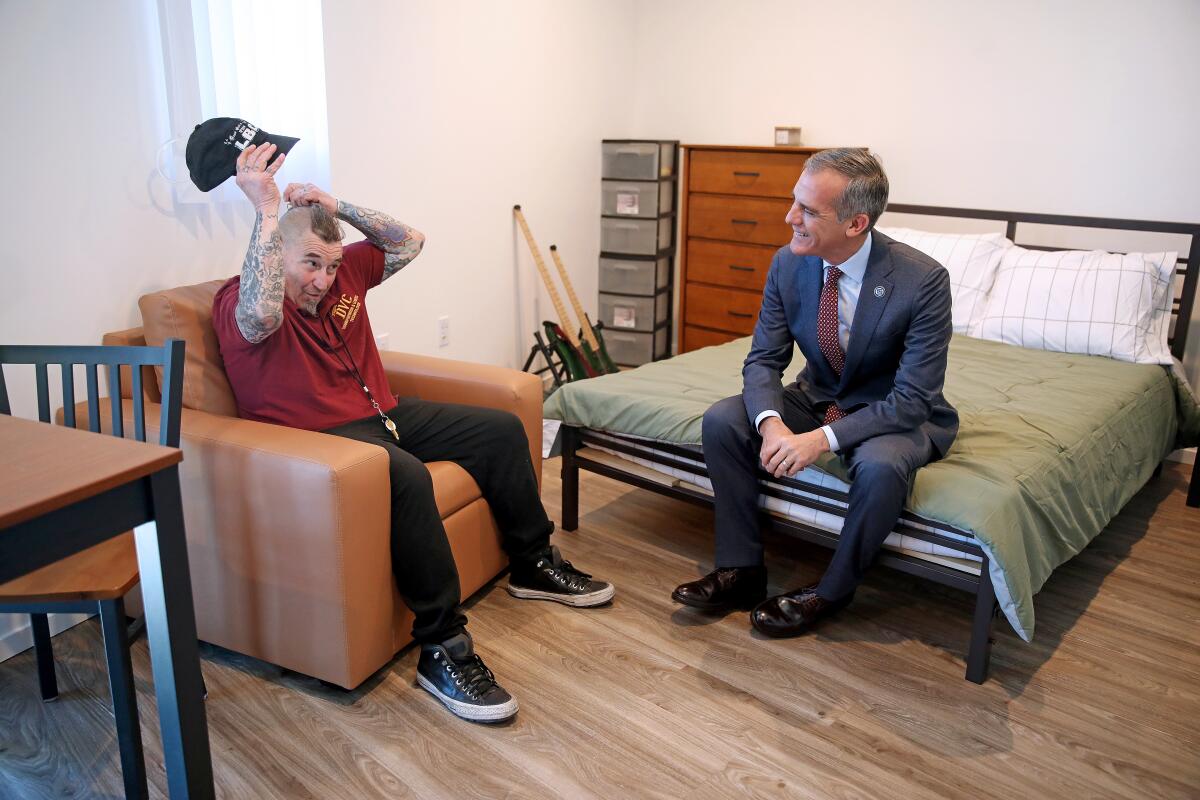
Also, Garcetti became the public face of Proposition HHH, the initiative backed by voters in 2016. The measure won approval along with the county’s Measure H to build permanent supportive housing — bolstered by mental health counseling, job placement and other services.
High costs forced the city to dip into other pots of money to remain within striking distance of building the 10,000 units that HHH alone was intended to fund, as the cost of units spiraled as high as $837,000. But even that number would put only a dent in the census of unsheltered people, which grew more than 7,000 after the 2016 passage of the ballot measure. Outreach workers counted 41,980 homeless people this year.
Planners had hoped that an improving economy would help more people afford homes. But with inadequate new construction, the price of apartments shot ever higher, driving more people out of housing.
Garcetti’s biggest homeless initiative — to put shelters in every council district — helped add more temporary shelter space than ever. But the program fell short of its goal, as many people in the shelters went back to the streets and promises to communities of enhanced policing and increased cleanups didn’t always materialize.
Jessica Lall, chief executive of the Central City Assn., a downtown business group, said in an interview last year that she had encountered women in Venice and downtown, both partially naked and in dire straits.
“Now, almost daily, no matter where I am in the city, there is some sad and horrifying thing that I see,” said Lall, who briefly ran for mayor this year. “It’s just really bleak.”
Critics said Garcetti failed to buck conventional thinking to change the trajectory of the crisis.
Venice activist Mark Ryavec raised money and supported Garcetti in 2013, largely based on the candidate’s promise to clean up the Venice boardwalk. Once elected, though, Garcetti and his staff didn’t even return phone calls, Ryavec said. He also faulted the mayor for initially declining to try out-of-the-box solutions, like construction of smaller apartment units with shared bathrooms.
“The mendacity that was exhibited was breathtaking,” Ryavec said. “And my personal experience reflects the broader public experience; this mayor was not up to dealing with the challenge that he faced with the homeless issue.”
Garcetti said he regretted that some constituents felt unattended. But he said he embraced an entrepreneurial approach — trying as many solutions as quickly as possible — to see what worked. “I think we’ve done as much as anybody in the country” on the many facets of reducing homelessness, he said.
After six years of disappointing progress, HHH construction surged just as Garcetti was leaving office, with more than 800 units due to be completed in December — the most in any single month — and more than 500 expected in January.
His defenders say that L.A. mayors simply do not have the power, alone, to provide the mental healthcare and housing needed to fix the problem. Indeed, a recent poll found that more than 53% of L.A. voters agreed that the Garcetti administration “effectively addressed the issue.”
Watch L.A. Times Today at 7 p.m. on Spectrum News 1 on Channel 1 or live stream on the Spectrum News App. Palos Verdes Peninsula and Orange County viewers can watch on Cox Systems on channel 99.
Successes: Transit, seismic safety, minimum wage
Garcetti claimed clearer achievements on other fronts.
Pushed by labor unions in 2015, he agreed to establish a $15 minimum wage, which this year increased to $16.04. Madeline Janis, a longtime activist for low-wage workers, praised the mayor with shucking off “enormous pressure” from business interests to support an increase that “has made a huge difference in the lives of hundreds of thousands of families.”
In the same year, Garcetti signed America’s most sweeping seismic-safety regulations, requiring the retrofitting of an estimated 15,000 buildings. Seismologist Lucy Jones said efforts to require the retrofits had been stalled for at least two decades and some of Garcetti’s staff balked at imposing the especially costly fixes needed for concrete buildings, with benefits that would be realized years, or decades, after he left office.
But the mayor insisted. “I was really impressed by his intelligence,” Jones said. “He understood what was needed to make Los Angeles safe.”
He continued improvements in L.A.’s rail grid, getting a huge boost when he helped win voter approval in 2016 of Measure M, a half-cent sales tax that will pay for the completion of long-delayed projects, like a rail connection to Los Angeles International Airport and a subway beneath Wilshire Boulevard, connecting downtown and the Westside.
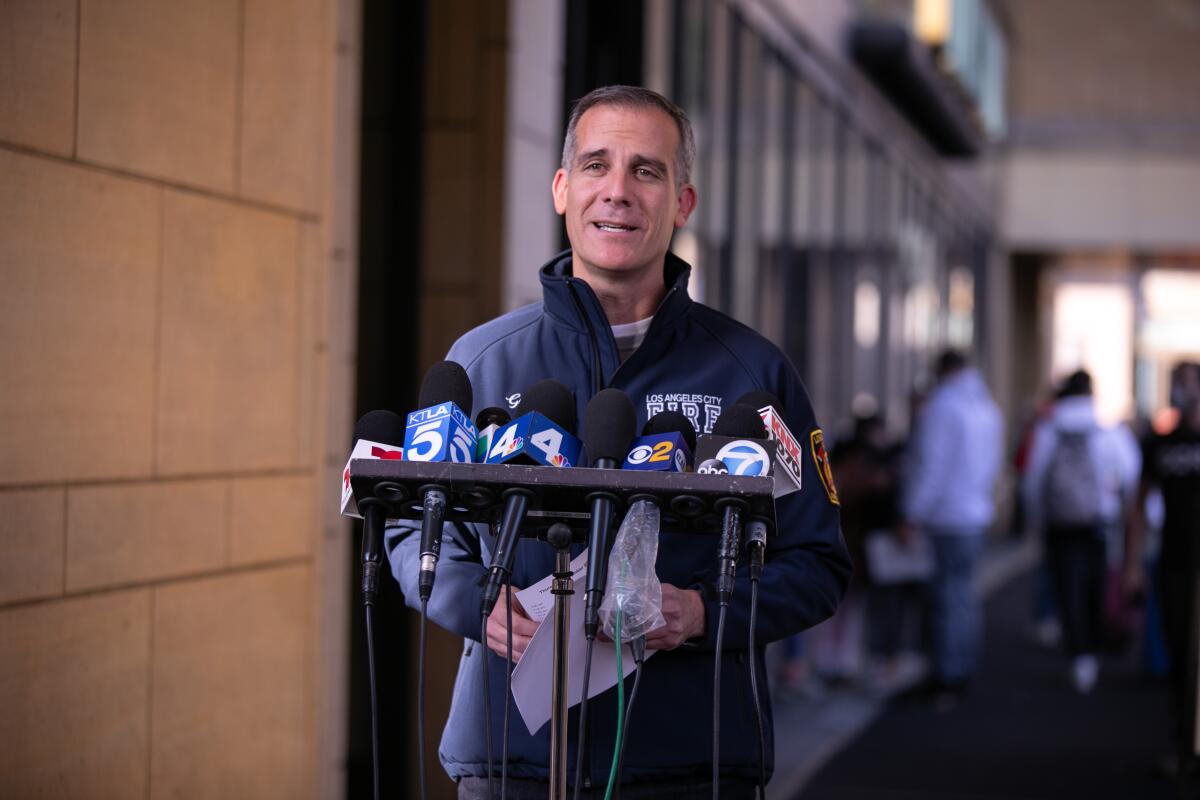
Garcetti and his appointees on the Metropolitan Transportation Authority board faced criticism, though, for not doing more to bolster bus and train ridership, which in the years before the pandemic fell more dramatically in L.A. than in other big cities, particularly hurting L.A.’s low-income riders.
Higher ambitions had slipped, at least temporarily, from view by the time of the last great crisis of his mayoral tenure — the COVID-19 pandemic. Without any official authority over public health, Garcetti nonetheless pushed hard to open testing centers and vaccination sites, turning Dodger Stadium into a landmark for care.
When the disease spiraled upward in early 2020, the mayor went on television nightly to console and guide Angelenos, scolding them for overcrowding public spaces, chastising them for hoarding food and supplies, and coaching them on the right way to wear a mask.
“I think we were really extraordinarily blessed and fortunate to have such a strong mayor in the city of L.A.,” said Barbara Ferrer, L.A. County’s public health director. “He took the appropriate steps to protect people and then acted with both diligence and rapidity as circumstances changed.”
His allies felt that Garcetti’s nature didn’t mesh with the small bore, back-to-basics rhetoric that launched his administration. He was, after all, the mayor who liked to quote the poet Robert Browning, urging that “a man’s reach should exceed his grasp.” So they weren’t surprised when the mayor unveiled a few big ambitions.
Garcetti pledged that a “Great Streets” program would remake 15 of L.A.’s landmark boulevards. But the mayor’s expansive idea was watered down, with the program ultimately focused on smaller improvements. He signed on to a national campaign to eliminate all traffic fatalities. Instead, deaths among pedestrians and drivers in L.A. climbed.
Former Mayor Villaraigosa had muscled through big initiatives on transportation and energy, and Garcetti pressed forward in that vein, with the fate of some climate change-focused pledges uncertain until long after he leaves office.
L.A.’s last coal-fired power plant is slated to close in 2025, and DWP officials are taking steps to reach Garcetti’s target of 100% climate-friendly electricity by 2035.
Similarly, Garcetti touted more sustainable sources for water, urging recycling and reuse of sewage water and stormwater over a singular reliance on imports from the Owens Valley and Colorado River.
To advance that goal, Garcetti used his clout on the Metropolitan Water District to help get the giant agency to hire a chief executive, Adel Hagekhalil, seen as friendlier than his predecessors to recycling and reuse.
Garcetti also set a 2035 deadline for getting 35% of the city’s water from recycling, a vast increase from the current 2%. Meeting the water and power goals will require major breakthroughs in funding and technology. The conversion of wastewater to reusable groundwater, alone, will cost an estimated $8 billion.
“He digs into this stuff and really understands it and commits to it at a completely different level than most elected officials,” said Mark Gold, an environmental scientist who helped write Garcetti’s environmental plan. “He could be teaching sustainability at any university in America.”
Battles over police funding
On other issues, some former aides and critics called Garcetti’s approach overly cautious and designed to avoid conflict, which they said makes him uncomfortable. In trying to map out a compromise “third way,” he sometimes frustrated the right and the left. Nowhere was that clearer than in the furor over policing that followed the 2020 murder of George Floyd.
Day after day, mass protests by Black Lives Matter and other groups demanded that the city shift the bulk of its budget away from the Los Angeles Police Department.
Garcetti went to First AME Church in South Los Angeles and said the enormity of the moment left him compelled to act. He pledged to shift some money from the LAPD to community “peace centers,” a new Department of Civil and Human Rights and other initiatives.
It felt like a transformative moment, in a city where growing the Police Department had been an article of faith for at least three decades. Garcetti and the City Council agreed to cut LAPD funding by $150 million in 2020, with the mayor going further and pledging a total of $250 million for communities of color.
But he achieved his goal by tapping federal funds that he directed toward homelessness, disappointing some who wanted far deeper cuts in the police budget.
The next year, as crime rose, the mayor still sought a middle path.
“If you want to abolish the police, you’re talking to the wrong mayor,” Garcetti said in his State of the City speech last year. “If you want to move backwards towards a failed us-and-them strategy that made police an occupying force in communities they were meant to serve, you’ve come to the wrong place.”
Garcetti could also share credit for another important policing reform — pushing to outfit LAPD officers with body cameras, telling the public that “trust is built on transparency.”
That action, and the brief trimming of the LAPD budget, went too far for some supporters of the police and not nearly far enough for those who demanded reform.
Leaders of Black Lives Matter Los Angeles were flabbergasted when the mayor began adopting activists’ language, without crediting or including them, following Floyd’s death. First, Garcetti talked about “reimagining public safety” and then later advanced a plan, first proposed by activists, to allow neighborhoods to participate in the city budgeting process.
Albert Corado, a one-time candidate for City Council in Garcetti’s old Hollywood-area district, said the city should push resources away from police and toward services like parks, transit and help for homeless people. Said Corado: “More money for the police is not the answer to this problem.”
At the other end of the political spectrum, Angelenos watched the murder rate rise in recent years and felt the opposite imperative — to hire more cops.
“We need more police and we need more politicians to back them up,” said Leny Freeman, a retiree who lives in Sunland-Tujunga.
Corado embodies a rising phenomenon of Garcetti’s second term: pronounced anger and disappointment from some progressives, who saw in the mayor’s actions not bold leadership but positioning for future political campaigns.
Shortly after President Trump took office in 2017, a group of activists for immigrant rights pressed for a meeting with Garcetti. But when they told Linda Lopez, who headed Garcetti’s office of immigrant affairs, that L.A. should be declared a sanctuary city, they recalled her saying such a stance would “not bode well in the Rust Belt.”
“Our first response was incredulity. Our second response was ‘Is he mayor of L.A. or of the Rust Belt?’ ” said Andrés Kwon, a member of the group and a lawyer with the American Civil Liberties Union of Southern California. “It felt like it was all about political expediency over actually protecting these vulnerable constituents. That’s not the kind of political leadership we need.”
Garcetti subsequently issued an executive order, affirming that police and other city employees would not assist in actions to deport or limit the rights of immigrants. The mayor suggested that declaring L.A. “a city of safety, refuge, and opportunity for all” embraced the activists’ goals.
Lopez did not respond to a request for comment. Garcetti said he settled on the most effective language to advocate for immigrants. “I’m a total friend and ally on this,” Garcetti said. “I’ve spent my whole life being as pro-immigrant as they come.”
The mayor’s innermost political circle suffered a heavy blow in the summer of 2020, when a member of Garcetti’s security detail said he had been subjected over several years to inappropriate touching and crude sexual remarks by Rick Jacobs, one of Garcetti’s closest confidants.
The allegations became increasingly problematic for Garcetti, as former top aides said in sworn statements that Jacobs’ behavior was such common knowledge it would have been impossible for the mayor not to know. Garcetti said he knew nothing about the allegations until LAPD Officer Matthew Garza filed a lawsuit against Jacobs and the city.
Get the lowdown on L.A. politics
Sign up for our L.A. City Hall newsletter to get weekly insights, scoops and analysis.
You may occasionally receive promotional content from the Los Angeles Times.
Beyond casting doubt on the mayor’s credibility, the Jacobs furor also raised questions about his judgment: Why had he put so much trust in an aide whom many others found so problematic? Had he been unaware of a sometimes cliquish and toxic office culture, with another top aide, Chief of Staff Ana Guerrero, dishing out Facebook insults against prominent politicos?
Even to some who had once been loyal to Garcetti, it seemed there were two answers, both unflattering: Either he was so detached that he didn’t know, or he knew and did nothing to stop it. Garcetti’s public response — repeated over many months, as new details emerged — was that he knew nothing about the misbehavior by his inner circle.
Tom Hogen-Esch, chair of the political science department at Cal State Northridge, said the Jacobs case gave the appearance Garcetti may have “looked the other way,” adding: “It’s really out of step with the historical moment that we’re in, where we are reexamining issues around … workplace sexual harassment.”
Landing the 2028 Olympics
Garcetti might look back fondly on highlight moments, such as late-night TV appearances with his friend, Jimmy Kimmel, or playing piano alongside Moby and the Los Angeles Philharmonic. The youngest mayor in 100 years, the first Jew elected to the post and a fluent Spanish speaker, Garcetti seemed like a man tailor-made for hyper-diverse L.A.
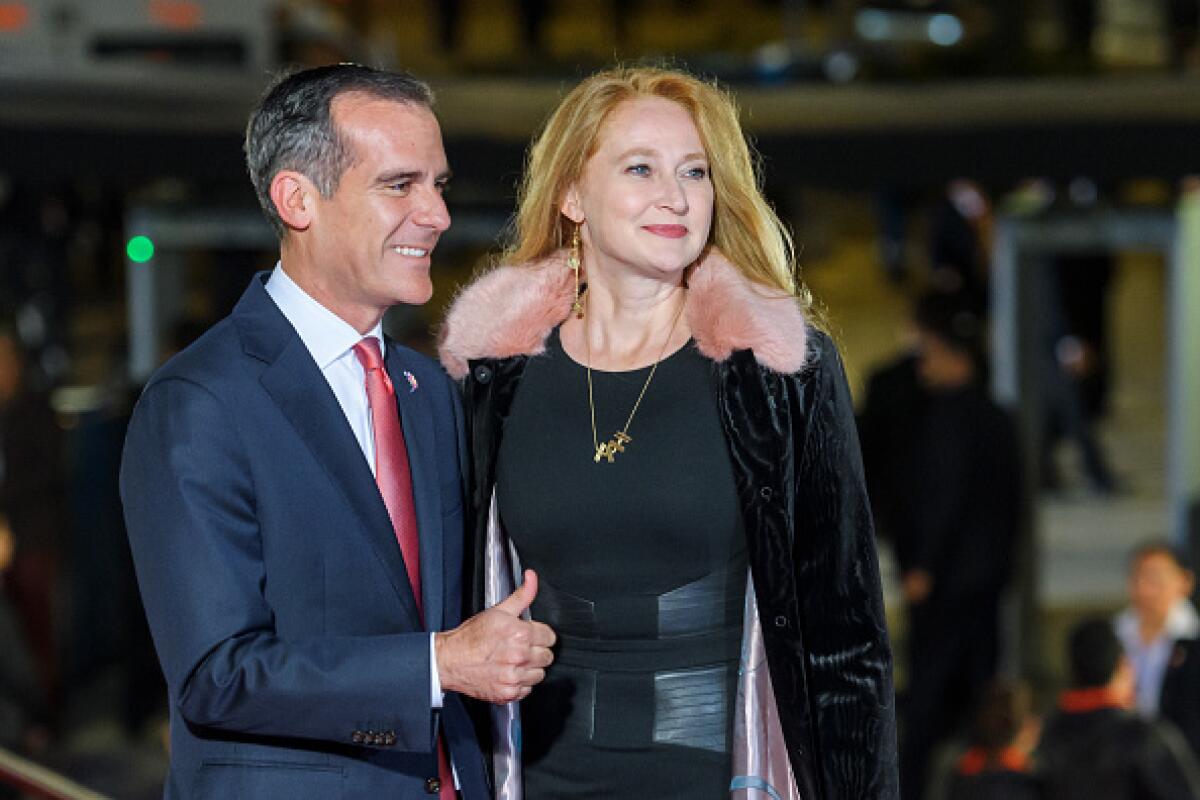
After his landslide 2017 reelection, he appeared on lists of up and coming leaders. President Obama had anointed him, after all, as one of the Democratic Party’s rising stars. By 2020, he was handpicked by Biden’s team to help the Democratic nominee vet vice presidential choices.
As his last hours as mayor approach, Garcetti is likely to recall his first. He signed a letter on July 1, 2013, to the U.S. Olympic Committee saying that Los Angeles wanted to host the 2024 Olympic Games.
Enamored as a 13-year-old with the 1984 Summer Games in Los Angeles, the mayor relished the idea of bringing L.A. the Games for a third time. His fervor overflowed in meetings with International Olympic Committee board members, whom he often charmed by reeling off a few sentences in their native languages. “He loved that stuff,” said one aide. “And he was really good at it.”
L.A.’s bid became something of a fait accompli when other American and foreign cities pulled out of the running. In 2017, Paris beat out L.A. for the right to host the 2024 Games. But in an unusual maneuver, the IOC simultaneously awarded Los Angeles the 2028 Games, making the city both an also-ran and a winner.
“What does history feel like?” Garcetti declared. “It feels like this.”
For the last L.A. Olympics, a voter-approved ballot measure and an uncompromising Mayor Bradley assured that the city bore no financial liability if the Games lost money. The event generated a $225-million surplus that still helps fund athletics programs for kids and training for elite athletes.
Garcetti extracted no such financial guarantees for the 2028 Games. But the mayor insists there “is a 99.99% chance that the city is not going to be on the hook for anything.” He predicts the city will profit more than other host cities because it negotiated to keep a 20% share that normally goes to the IOC, along with a program that will inject $160 million into underserved communities for things like youth swimming programs.
Still, other host cities have faced censure for the high cost of the quadrennial spectacle, in the face of more dire social needs. No one can say whether that tension will arise again in 5½ years, when the Games of the XXXIV Olympiad are set to open at SoFi Stadium and the Coliseum.
Times staff writers Doug Smith and Laura J. Nelson contributed to this report.
More to Read
Start your day right
Sign up for Essential California for news, features and recommendations from the L.A. Times and beyond in your inbox six days a week.
You may occasionally receive promotional content from the Los Angeles Times.
